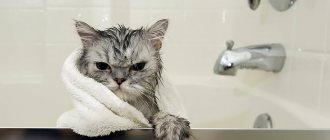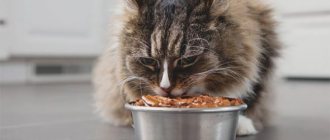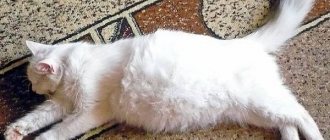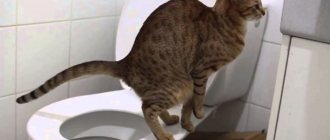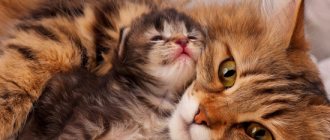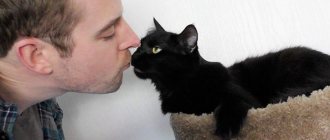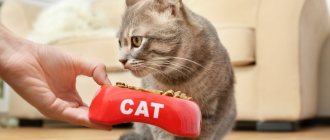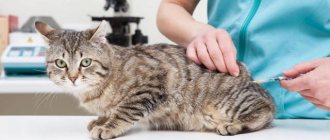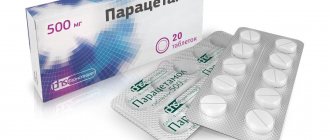Poor nutrition, poor quality food or a sedentary lifestyle can lead to diseases of the genitourinary system in our pets. Cats experience acute pain, difficulty urinating, and blood may appear in the urine. In some cases, when stones block the urinary ducts, the animal dies.
Since cats are the most susceptible to urolithiasis, experts advise prevention, and if the disease occurs, treat it with KotErvin. According to veterinarians, this drug is very effective and completely safe for animals.
Kotervin composition
The natural composition of the complex includes:
- bird knotweed (the urological composition contains at least 1.5%);
- horsetail (its urological composition is 0.5%);
- steelberry root (it is 1% in the described medicine);
- knotweed (this component occupies 0.5% of the total composition);
- distilled water (its content in the substance is not less than 96.5%).
The drug is a transparent solution of light brown color (sometimes it may have a dark brown color). The product has a persistent herbal smell. If a slight sediment appears at the bottom of the bottle, this is normal. The container with the solution will need to be shaken well before use.
In what form is the drug available?
Kotervin drops are available in glass bottles of 10 and 16 ml. The package includes a dropper cap and instructions. The cardboard box always indicates the manufacturer (it is a well-known Russian one), its address and official trademark. The packaging will also indicate the composition of the medicine, the volume of the solution in the bottle, the purpose for which the drug is prescribed, the method of use, the expiration date and recommendations on storage conditions. There is also an indication on the box that the drops are intended for animals. There is a clarification that the drug is sterile, has a quality mark and has passed official radiobiological control.
The drug Kotervin: pharmacological characteristics
The effectiveness of Kotervin infusion is guaranteed by its biologically active composition, which is extracts from plants. The main active ingredient is the bird knotweed plant (popular name - knotweed). Due to the content of tanning components, vitamins, flavonoids and silicic acid, stones that quickly accumulate during urolithiasis are removed from the body. Bird knotweed is also good because it has a diuretic effect. The medicinal plant is also characterized by an anti-inflammatory effect and the property of strengthening the walls of blood vessels.
Horsetail is valuable because it contains silicic acid (25%), flavonoids, and triterpene saponins. The complex of organic elements guarantees an anti-inflammatory effect, stops bleeding and stimulates urine output. These properties are important in the presence of diseases of the genitourinary system in a cat.
The knotweed, contained in the described urological preparation, is characterized by the properties of the avian knotweed. The main effect of the plant is aimed at dissolving stones in the bladder and relieving the inflammatory process. An extract from the roots of field steelhead increases the volume of urine excreted, normalizes smooth muscle tone, and eliminates pain.
Pharmacological properties of Covertal
The action of Covertal is determined by the properties of the raw materials. Thistle and colocynth stimulate liver function, dandelion is an antispasmodic, improves the flow of bile, strengthens the liver. Celandine is famous for its bactericidal and choleretic effects.
What does Covertal do:
- increases the resistance of liver cells to attack by inflammatory agents;
- helps restore liver function, activates its neutralizing activity;
- improves metabolic processes.
The drug Covertal stimulates liver function and improves metabolic processes.
What is the effect of Kotervin?
Due to the presence in the preparation of a number of acids, tannins, flavonoids and vitamin components, the organic complex provides the following pharmacological effects:
- rejects salt deposits;
- dissolves stones in the urinary system;
- stimulates the diuretic effect;
- stops bleeding;
- removes the inflammatory process;
- eliminates spasms and pain.
Laboratory and clinical studies of the herbal infusion have allowed it to be classified as a safe medicine. A high level of safety is ensured by the absence of chemical and toxic components in its composition. Under its influence, there is no harm to the embryo and there is no accumulation of dangerous components in the cat’s body.
Despite all the positive aspects of the infusion, its use should be done as prescribed by a veterinarian, and how often Kotervin can be given to a cat should also be decided by a specialist.
Indications for use
The main indication for the use of Kotervin is the presence of urinary tract dysfunction in cats, as well as the formation of sand and stones in the bladder. These diseases are accompanied by:
- retention of urine (urine);
- frequent urge to urinate;
- pink tint of urine (the color of urine indicates the presence of blood in it);
- edema (swelling can be seen in the genital area);
- pain (trips to the toilet are accompanied by loud meowing, as the animal feels severe pain during urination).
The drug is also prescribed by doctors to prevent exacerbation of urolithiasis. It can be used in combination with other medicinal products.
Causes of diarrhea in cats
- Poisoning with toxic substances. Eating toxic substances and poisoning with them. Often cats can eat indoor flowers and plants, household chemicals, various flammable liquids, expired and low-quality medications. With such poisoning in a cat, cat or kitten, diarrhea is often associated with vomiting and convulsions. In this case, the owner should lavage the cat’s stomach as soon as possible and give adsorbents (for example, activated carbon) to drink.
Poisoning by poor-quality or unusual food for the animal. Often, for the sake of a joke, the owner can treat his pet to alcoholic drinks, sweets, or dishes that are overly flavored with herbs and spices. In this case, the animal may experience an upset stomach, bloating, and gases. In this case, diarrhea in a cat, cat or kitten is most often one-time and does not cause significant harm to the animal. The owner should remember that cats are not people, and such food is harmful to them!
Abrupt transfer of an animal to a new food. When switching an animal to a new food, you should carefully read the recommendations of the food manufacturer. As a rule, a new product should be introduced gradually, starting with small portions. For this reason, diarrhea in a kitten, cat or cat is short-lived.
Allergic reactions in an animal. Regardless of age and breed, an animal may have a reaction to one or another allergen (cigarette smoke, pollen, perfume). Diarrhea in an animal can often be a side effect of an allergy. If, in addition to an upset stomach, your cat experiences watery eyes, itching, vomiting, sneezing and coughing, then most likely it is an allergy.
Hairballs in a cat's stomach. Often cats, when licking themselves, absorb large amounts of their own hair. This is especially true for furry individuals. In addition to diarrhea, in this case the cat may vomit with hair clots. The owner should comb the pet thoroughly and, if necessary, give the animal special medications to prevent the formation of hairballs.
Bacterial infection. This cause of diarrhea in a cat is very dangerous; the stool is foul-smelling, with mucus, and sometimes bloody clots can occur. The animal is lethargic, looks unhealthy, and has no appetite. The cat may develop a fever and vomit. The presence of blood in the stool is the reason for immediate contact with a specialist.
Viral infection. Viral infections in cats are often accompanied by vomiting, discharge from the nose, and eyes. The animal's stool is liquid, the cat's temperature may rise or fall, and its appearance indicates illness. In cases of virus infection, medical intervention is mandatory.
Diseases of the small or large intestine. The cat has repeated bowel movements, and mucous and blood clots are common. Sometimes the stool turns dark (brown or black), in which case the animal may have intestinal bleeding.
Intestinal obstruction. Stools with intestinal obstruction in cats are frequent, liquid, and associated with vomiting. Touching the stomach causes pain in the cat.
Diseases of the pancreas. Cat stool has a yellow-green tint. With weight loss, the animal has a good appetite. Flatulence is often observed in the animal. With such diseases (chronic or acute pancreatitis), the destruction of the pancreas begins, and the animal may even die. The cause of such diseases can be overweight or underweight, congenital pathologies in the animal, infections, inflammation, poisoning. It is necessary to consult a doctor as soon as possible and undergo the necessary tests. If the cat is lethargic, has difficulty breathing, the smell of liquid feces is sour, and the temperature is elevated, this is a reason to suspect problems with the pancreas.
Stress. Often, a non-standard or unusual life situation, a surge of emotions, fear or mental discomfort (for example, participation in an exhibition, a change of home) can cause a short-term stomach upset in a cat. At the same time, the owner should show maximum attention to his pet.
Benign and malignant tumors (cancer) in cats. Such diseases cause not only diarrhea, but also vomiting, loss of weight, appetite, interest in life, discharge or unpleasant odor from the nose, mouth, and eyes. Females and older animals are especially susceptible to cancer. You should not waste precious time and consult a doctor as soon as possible to take a biopsy and undergo tests for upcoming treatment.
Kidney diseases. Often diseases of these internal organs are accompanied by diarrhea in the cat, lack of appetite, frequent urination, vomiting, and difficulty urinating. For such diseases, consultation with a specialist is recommended, and a change in the animal’s diet is advisable. It is undesirable for the cat to overheat or be in a draft.
Liver diseases. Such diseases are characterized not only by abnormal bowel movements, but also by dark colored urine. The cat's belly is swollen. Cats are advised not to eat for a day, then switch to cereal. Testing and consultation with a doctor are required.
- Cow's milk intolerance in kittens. In addition to the above reasons for diarrhea in kittens, such problems may also arise when switched to cow's milk.
Kotervin for cats instructions for use
The dosage of Kotervin directly depends on the diagnosed disease and the severity of its manifestation. Typically, the medicine is taken orally. Let us consider the features of the use of the drug and the dosages required in different cases.
Kotervin method of use for the prevention of urological diseases
To prevent and prevent exacerbation of a chronic urological disease, veterinarians prescribe Cotervin for cats to take 2-4 ml once a day (the duration of the treatment course is 7 days). The duration of treatment is determined by the doctor based on the stage of the disease. The owner of the cat should be guided by the peculiarities of the course of this disease in the past. To prevent the chronic condition from getting worse, it is recommended to repeat preventive courses after 3-4 months.
Kotervin instructions for situations when the disease is at the initial stage
The drug described above involves the treatment of urological syndrome in four-legged animals and is guaranteed to provide a lasting positive result at the initial stage. If a cat has problems with the bladder for the first time, then Cotervin is prescribed, the dosage for oral use will be 2-4 ml of solution 2 times a day. Treatment should be carried out for 7 days.
To effectively relieve symptoms, veterinarians often prescribe Kotervin to be taken as part of complex therapy.
How to give Kotervin if there is blood in your pet’s urine
When a urological disease in cats is accompanied by bleeding and an increase in pH level, a therapeutic urological drug is given orally 3 times a day, 2 ml. In addition to Kotervin, the animal will also be prescribed additional medicinal compounds.
The cat cannot urinate on its own. What is the dosage in this case?
In cases where, due to illness, the pet is unable to go to the toilet on its own, the pet owner will have to resort to radical measures. The difficulty of treatment will be to administer the medicine into the cat’s bladder once every 2 days, 10-16 ml.
Attention! Before injecting the therapeutic solution into the bladder with a catheter, you will first need to free the diseased organ from residual urine. To perform the procedure, the drug is drawn from the bottle with a sterile syringe. Then the needle is removed, a catheter is installed in its place and the medicine is injected into the inflamed bladder.
Kotervin instructions for use for cats with inflammatory syndrome
With the help of Kotervin, you can quickly relieve the progressive inflammatory process that has arisen in the cat’s genitourinary system. If inflammation occurs with concomitant infection, Cotervin with Neoferon is carefully injected into the bladder for 3-5 days.
Give the medicine mentioned above to animals orally using a dropper nozzle (a teaspoon) or use a syringe without a needle. The drug can also be mixed with a small amount of milk or water.
Attention! Veterinarians, when prescribing Cotervin to cats, always warn animal owners that the occurrence of urolithiasis is associated with poor diet. Therefore, you will definitely need to adjust your four-legged friend’s diet.
Schemes for using Covertal
Covertal is injected subcutaneously or into a muscle.
A single dose depends on the animal’s body weight: 0.1 ml per 1 kg. For a dog it should not exceed 4 ml. That is, if the dog weighs more than 40 kg, the maximum permissible injection volume is still 4 ml.
In case of poisoning with substances toxic to the liver, in the case of infectious and invasive diseases, one injection is prescribed every 1–2 days for 2–3 weeks. Conduct 2–4 courses per year.
The dosage of the drug Covertal is selected based on the animal’s body weight and the type of disease.
In the case of chronic liver disease, the frequency of administration is the same, the course duration is 3–4 weeks. In acute cases, 1-2 injections are given per day.
For hepatitis, daily injections of Covertal are prescribed for 10–14 days.
Important! In addition to following the drug treatment program, it is important to strictly follow the prescribed diet and improve the dog’s emotional state.
Kotervin side effects
As a rule, there are no side effects from Kotervin. However, the factor of individual intolerance of the cat’s body to one of the components cannot be excluded. This factor can cause an allergic reaction, which you may have already encountered before. In such cases, the veterinarian selects a medicine with a similar effect, but with other components.
For your information! Treatment of animals with this drug is possible at home. But subject to strict adherence to asepsis rules. If suddenly the solution in the bottle changes color or suspicious inclusions appear in it, then you should stop using the medicine.
Treatment of cat diarrhea
In cases where the animal is seriously suffering, it is clear from its appearance that the disease is caused by an infection or diseases of the internal organs, if loose stools are accompanied by vomiting, discharge from the eyes, nose and other signs characteristic of severe conditions - treat diarrhea in a cat, cat or kitten at home is strictly prohibited! Because self-medication can be harmful, and the owner and cat will lose precious time, which could correct the situation during treatment under the supervision of a specialist.
Contraindications
Despite the fact that Kotervin for cats is considered a safe drug by all researchers, experts do not recommend taking it if the animal has severe renal failure.
We should also not forget that the development of an allergic reaction can occur due to the action of some herbal component. If problems with the urinary system occur in a pregnant or lactating cat, it is worth consulting with a veterinarian about the possibility of using the drug.
Contraindications, side effects, compatibility with other drugs
Kotervin has few contraindications for use:
- increased individual sensitivity to the components of the product;
- acute renal failure.
Since the drug is completely natural and does not have a negative effect on the fetus, it can be given to kittens and pregnant cats.
There are usually no side effects. Sometimes there is a cat “intoxication”, excitement after the medicine. If, after taking the drug, the cat exhibits an individual sensitivity reaction or you notice any symptoms of poor health, stop using the drug and carry out symptomatic treatment.
There is no information that Kotervin is incompatible with any other drugs. There are also no data on overdoses.
Video: cats got drunk on Kotervin
Advantages and weaknesses of the drug
The main advantage of Kotervin is its high effectiveness, proven not only by clinical studies, but by the results of practical application. Researchers have proven that out of 120 sick animals, long-term remission of the disease occurred in 90 cats.
At the same time, the treatment was carried out comprehensively; along with Kotervin, the animals were given antibiotics and medications to relieve pain and eliminate spasms. And, of course, a strict diet was recommended. Considering the advantages of the medicine, it is worth noting such important positive factors as:
- natural composition of the complex;
- absence of chemical components and preservatives;
- no contraindications;
- normal taste characteristics (the drug has no bitterness or disgusting aftertaste);
- good compatibility with other medicinal products;
- effective effect on the diseased organ in combination with other drugs.
The disadvantages of the medicine include the inability to dissolve oxalates, the need to store the bottle in the refrigerator after opening it, and the short shelf life of the drug after opening (it is 7 days). Also, practical experience in using the medicine speaks of an inconvenient pipette, which is easily replaced with a disposable syringe.
Types of discharge in cats
How can a cat be poisoned? - plants indoors and outdoors
- medications (eg, acetaminophen, NSAIDs, antidepressants, methylphenidate). Eat both your tablets, left in an accessible place, and if you yourself give the animal any drugs prohibited for animals or an overdose/incorrect application, for example, when treating with parasite drops. Many people use drugs for dogs/people for cats, causing them to become poisoned. Remember, the medications you use should only be for cats or those prescribed by your veterinarian. And do not forget about dosages, strictly according to the weight of the animal or according to the doctor’s prescription.
— food poisoning (unsuitable food for cats, poor quality or spoiled). Strictly contraindicated - chocolate, caffeine, onions, garlic, fatty meats, purchased minced meat, citrus fruits, grapes/raisins, apricots, all types of mushrooms, persimmons, nuts, all products with spices, sausages, smoked meats, sweets, canned food for people and much more other. The diet must be balanced especially carefully if your cat is on a natural diet, because poisoning may not be acute, one-time, but will manifest itself over time as chronic pathologies. Try not to buy food in bulk; it can often be spoiled; manufacturers recommend keeping the packaging sealed.
- chemicals, disinfectants in the house, poorly washed floors or other parts of furniture with leftover products can also cause cat poisoning. In case of poisoning with detergents, there may be: Vomiting, diarrhea with blood, difficulty breathing in the animal, convulsions. It is necessary to immediately give a large amount of water and take the cat to the clinic.
- Lead contained in paint, linoleum and batteries - a cat can be poisoned if it eats it.
— Apartment renovation is not only a big stress for many cats, but also a cause of poisoning in animals, for example, when you glue wallpaper, paint and other substances may attract your cat to taste
What plants can poison a cat? Considering our case with fake grass Plants that are poisonous to cats, this is a whole epic. It is very important to limit the contact of cats' faces with some of the plants that owners love so much and unknowingly bring home
Lilies are very poisonous to cats, causing acute kidney failure, vomiting, and lethargy. Cycad palms - cause vomiting, constipation/diarrhea, mainly affecting the liver.
Azalea, laurel, and aloe can cause diarrhea. Begonia - burns mucous membranes.
Asparagus and geranium (the whole plant is poisonous to cats, but especially the leaves) – stomach upset
Other toxic plants - yew, autumn crocus, foxglove, lily of the valley, ivy, boxwood, cyclamen, cyperus, iris, narcissus, snowdrop, calla lilies, hyacinth, tulip, chrysanthemum, belladonna, adonis, aconite, acacia, henbane, geranium, wisteria, St. John's wort, jasmine, honeysuckle, tansy, hellebore, celandine, onion, tomato, elderberry, dandelion, physalis, ficus, rhubarb and violet.
Remember that cats do not always choose only what is beneficial for themselves and not all grass and plants that they can eat are harmless to them. It is important to grow flowers at home that are not dangerous to cats; gift bouquets should also be inaccessible to them.
What are the types of poisoning in cats in the summer, during the summer season? For example, if in the summer a cat is walking on its own in the countryside, when going outside, animals, including cats, are at risk of being poisoned by substances that can poison them - rats, cockroaches, chemicals that are sprinkled on roads.
Poisoning with rat poison can lead to various bleeding (a characteristic sign) and shortness of breath. The antidote, vitamin K1 konakion, is quite difficult to find in our pharmacies, and doctors in clinics may begin to use other hemostatic agents and then search for konakion.
Fertilizers on plots are also dangerous during the summer season. Lawn and garden products can be toxic to animals who ingest them when they wash themselves after walking or lying in a recently treated area.
Poisoning in cats living in an apartment - what must be hidden from the animal? It is important to keep all medications and chemicals out of the reach of animals. When they are poisoned, there can be either mild poisoning - vomiting, diarrhea, or fatal poisoning, due, for example, to acute renal failure.
The most common reason for visiting clinics is food poisoning, when they are fed either spoiled ready-made food or natural food unsuitable for animals.
Compared to poisoning with strong poisons, ingestion of inappropriate food is less likely to lead to acute life-threatening conditions, but causes chronic diseases. What does the liver, pancreas, and stomach most often react to? For any unfavorable signs, even mild ones, it is important to show your animal to a doctor and undergo the necessary tests, even if symptoms such as vomiting and diarrhea could be prevented on your own. A course of additional medications may be required.
Drug poisoning: what medications must be hidden from your cat? Paracetamol is contraindicated in cats; it can cause swelling of the face, cyanosis of the mucous membranes (cyanosis), shortness of breath, renal failure, gastritis/stomach ulcers. In dogs it can cause nausea, vomiting, lethargy, and pale mucous membranes, but may be asymptomatic.
Animals are also contraindicated in such painkillers - non-steroidal anti-inflammatory drugs such as ibuprofen and indomethacin - they are very toxic and can also cause poisoning aspirin, piroxicam, caroprofen, naproxen, phenylbutazone.
Their use with glucocorticoids is especially contraindicated. They can cause stomach ulcerations, stool and vomiting of blood (“coffee grounds”), abdominal pain, and acute renal failure. In case of poisoning with these drugs, it is necessary to induce vomiting, and in case of aspirin poisoning, the stomach can and should be washed out, even if 3 hours have already passed after poisoning, since aspirin can form conglomerates.
- The cat's back legs are taken away from him
- After the injection of No-shpa, the cat went limp as a rag and only resuscitation could save her
- A cat after No-shpa may remain lame for life
- No-spa causes paresis of the pelvic limbs
- My cat was injected with No-shpu - then she could barely walk and limped for a long time
Historical information: Drotaverine hydrochloride was synthesized at the Hinoin enterprise in 1961 on the basis of Papaverine, which had long been produced at the enterprise. So the drugs have a common origin.
Mechanism of antispasmodic action: both Papaverine and Drotaverine have an antispasmodic effect based on inhibition of the enzyme PDE-phosphodiesterase, the concentration of which in tissues determines the effectiveness of the use of Drotaverine and Papaverine in clinical practice. Under the influence of PDE inhibitors, the amount of cAMP (cycloadenosine monophosphate) in the cell increases and the amount of calcium ions decreases. And the fewer calcium ions in the cell, the lower the possibility of muscle fiber contraction. The result of this is a decrease in the tone and motor activity of the smooth muscles of the internal organs, which leads to the elimination of their spasm.
Duration and strength of antispasmodic action: Drotaverine has a half-life of 7-12 hours, while Papaverine has a half-life of only 1.5 - 2 hours. At the same time, the selectivity of the effect on smooth muscles of Drotaverine is 5 times higher than that of Papaverine.
pH of the injection solution: the degree of acidity of the administered solution of Papaverine and Drotaverine is 3-4.5, which indicates a possible local reaction with intramuscular and subcutaneous administration,
Metabolism of drugs: both drugs are metabolized in the liver and are excreted in the form of metabolites by the kidneys - Papaverine completely, Drotaverine - more than 50% (approximately 30% is excreted in the intestines with bile).
Penetration into tissues: Papaverine penetrates the blood-brain barrier and into all tissues; Drotaverine does not penetrate the central nervous system and does not affect the autonomic nervous system; it slightly passes through the placental barrier.
As can be seen from the comparison, some properties of the drugs Papaverine hydrochloride and Drotaverine hydrochloride are very similar, and the existing differences determine individual indications for the use of one or another drug.
However, if we are talking about the mechanism that causes the antispasmodic effect, the characteristics of metabolism and the direct effect on the smooth muscles of internal organs and blood vessels, then they are almost identical for both drugs. This means that there is no reason to say that one drug (Drotaverine) can cause reactions in cats that another drug (Papaverine) cannot cause.
It all depends on several important points in the condition and reaction of the body of a particular cat:
- Individual sensitivity of a cat to a drug
- Previous condition of the cat before the antispasmodic injection
- Local reactions to drug administration.
Let's take a closer look at each of these points:
As we have already mentioned, the more phosphodiesterase enzyme (PDE) in animal tissues, the stronger the antispasmodic effect of any drug will be - be it Papaverine or Drotaverine, but to Papaverine such a reaction will be about 5 times shorter.
Allergic and paradoxical reactions of a living organism to the administration of drugs occur regardless of the type of animal and the type of drug.
Excessive discharge of foamy saliva from the mouth can be associated both with the animal’s stress reaction to the environment of the veterinary clinic and the treatment process itself, and with the chemical effect of the administered drug on the cat’s body.
When Papaverine is administered, such reactions can be significantly (about 5 times) weaker and shorter, which is due to the lower selectivity of this drug, the possible sedative effect of Papaverine and the faster half-life of Papaverine compared to Drotaverine hydrochloride.
This is especially true for dehydrated animals and animals in a state of hypoglycemia. As soon as, thanks to the injection of an antispasmodic, the pain syndrome sharply loses its intensity, the torpid phase of pain shock begins: a sharp inhibition of all signals of the nervous system, entailing a drop in pressure (collapse). The animal suddenly relaxes (hangs like a rag), its reactions to external stimuli sharply decrease, the pressure drops sharply, which worsens the blood supply to the brain and often resuscitation measures simply cannot be avoided.
As can be seen from the description, this is not a side effect of the antispasmodic, but a natural pathogenetic process in the development of pain shock.
This is often observed with feline urethral syndrome (if urine output has stopped abruptly for more than a day) and with some types of dynamic intestinal obstruction, when sharp spasms and profuse distension of the intestine are observed as a result of gas formation.
That is why self-medication of animals in serious condition is unacceptable, because often the owner cannot take into account all the mechanisms that operate in the body of a seriously ill patient.
As mentioned above, solutions of both Drotaverine and Papaverine have an acidic reaction. Because of this, it is extremely undesirable for cats to inject such drugs into the subcutaneous or intermuscular (interfascial) fatty tissue. The consequence of such an injection will be a painful area of irritation at the site of injection of the drug, up to the formation of an inflammatory infiltrate.
But it happens that due to too small and poorly developed muscles (for example, in a kitten), the drug gets into the interfascial, paraneural or perivascular fatty tissue. In this case, a local reaction of the surrounding tissues to the acidic solution occurs. Brief soreness is possible, which is accompanied by lameness, as well as the development of a reactive inflammatory infiltrate.
Such an infiltrate will be more painful if it covers a nerve branch or is adjacent to the vascular wall, where there are more pain receptors. At the same time, if we take into account the possible (reactive) slowdown in absorption and the half-life of the drug, it becomes clear that the reaction to Drotaverine may be brighter and longer than to Papaverine.
If we consider that, as a rule, injections are given to cats specifically in the pelvic limbs, it becomes clear why a patient, after a few days of treatment with antispasmodic injections, may simply refuse to walk on his paws, every movement of which causes pain.
This problem can be reduced by using dry heat to accelerate the resorption of post-injection infiltrates.
In order to wisely and consciously choose what to use as an antispasmodic for a cat, it is necessary to take into account all the common points and differences in the properties of Drotaverine and Papaverine, which were reflected above.
What I advise you to focus on:
- Required duration of antispasmodic action
- Presence and severity of pain before using an antispasmodic
- The general effect that is expected from the use of an antispasmodic in a cat
- Individual reactions of cats to previous use of antispasmodics
Now let's look at all the landmarks in more detail:
If the spasm is not severe and/or short-lived, then an injection of papaverine is sufficient to relieve it.
So, if there is a need for ongoing monitoring of small intestinal spasms due to an infectious or invasive disease (especially in a kitten), I will prefer to use Papaverine, and in case of severe spastic pain due to poisoning, idiopathic cystitis, or with urolithiasis and urethral syndrome in cats, I will certainly choose Drotaverine hydrochloride
The higher the patient’s level of pain and the longer the duration of this pain, the more additional measures I will take to avoid getting that very torpid phase of shock. Before using an antispasmodic, I will catheterize a vein to administer drugs drip and maintain the patient’s pressure, and then I will use the antispasmodic that I deem necessary based on the above. If the effect on the central nervous system is undesirable, my preference will be given to Drotaverine.
If I use an antispasmodic only for the purpose of relieving an acute spasm in an animal free of chronic diseases, then I will focus on the required duration of the antispasmodic effect. If antispasmodics are used in an animal that has a number of chronic diseases, then the use of the antispasmodic begins to be limited by the patient’s body’s ability to administer the drug.
Considering the metabolism of the drugs in question in the liver, I would prefer to prescribe Papaverine to animals with suspected chronic liver pathology, slowing down the metabolism of which can affect my patient’s body more positively than negatively. In the case of Drotaverine, a slowdown in the metabolism of the drug can become more fatal for the patient due to its longer persistence in the body and, accordingly, higher risks of accumulation.
This point, it seems to me, needs little comment. It is clear that if previous experience with a particular antispasmodic was unsuccessful, then next time you should use a different drug and hope that the patient’s body will react to it in accordance with the best expectations of the doctor and owner.
Sometimes it happens that simply changing the treatment environment or injection technique significantly changes the cat's reactions to the administration of the drug. And this should also be taken into account when planning treatment for a patient.
We hope that our materials have shown you, dear reader, how many factors should be taken into account when choosing drugs to treat a particular patient.
Therefore, if you are the owner of an animal and it seems to you that this or that drug may be dangerous for your pet, ask your doctor to justify his prescription of this particular drug. It is possible that after a medical explanation everything will turn out to be not so terrible, but quite justified. And if something goes wrong, then contacting a doctor will help explain the problems that have arisen and quickly change the drug with an undesirable effect or the technique of its use.
This is much better than silently listening to the doctor, and then independently using advice from the Internet to change treatment at your own peril and risk, or to scold an innocent doctor for something that will not happen if you follow all the recommendations.
If you are a veterinarian, then when prescribing this or that drug, follow not myths and fears, but the knowledge of pharmacology, pathophysiology and clinical disciplines.
Natalya Troshina, veterinarian (DVM)
Sources of information about medicines:
No-Spa for cats is an antispasmodic drug necessary for the treatment of many diseases. Along with Papaverine and Spasmanet, the medication is used to treat urinary tract pathologies.
Analogs
Kotervin, whose price in veterinary pharmacies is low, due to its effectiveness and absolutely natural composition, is constantly in demand. If the medicine is not available at the pharmacy, it can be replaced with medications of a similar effect. Analogues of Kotervin:
- medicine "KotBayun";
- phytocomplex “Healthy Kidneys”, aimed at cats;
- “Stop-CYSTITIS” solution;
- "Divopride" (belongs to the category of nephroprotectors).
Owners of cats suffering from urological diseases are often interested in the question: Kotervini Stop Cystitis, which is better in case of cystitis. When comparing two drugs, their differences should be emphasized. Erwin cat is an exclusively herbal remedy. The Stop-Cystitis suspension, along with a large number of plant extracts, contains the antibiotic Nitroxoline.
Thanks to the latter, a powerful effect on harmful bacteria, fungi and infections is achieved. Therefore, when the disease of the urinary system is severe, doctors prescribe Stop-Cystitis for the cat. But if preventive treatment is required, Kotervin will be an ideal option.
Kotervin reviews
Numerous user reviews reveal interesting facts:
- There have been cases when Kotervin was prescribed in combination with antibiotics. At the same time, the cats refused to take antibiotics with a bitter taste. As a result, the treatment was carried out by Kotervin alone and a positive result was achieved
- Even owners of animals who are 3-4 years old give positive reviews of Kotervin. Problems with urination caused by diseased kidneys disappeared after 7 days without taking the drug.
- Veterinarians, assessing the drug, emphasize that they prescribe it for the treatment of urolithiasis in complex therapy, since the herbal composition cannot have a strong effect. As a preventive measure and in the early stages of the development of urological diseases, the drug shows high effectiveness.
Reviews from dog owners
Dog owners are satisfied with the drug and say that thanks to it their pets have recovered.
Zinaida, Luga. Our bull terrier is 6 years old. Suddenly my appetite dropped. Vomiting appeared, and I began to go to the toilet less often. The doctor noted dry skin. We took tests. The preliminary diagnosis is cholangitis. They prescribed a diet and Kovertal injections. The toilet became better after 5 days, and the dog began to eat normally after 10 days. Two weeks later we took tests again - everything was normal.
Svetlana, St. Petersburg. A 13-year-old greyhound began to faint. A blood test showed hypoglycemia, high bilirubin, LDH, ALT. They began to go for covert injections every day. After a week I felt better—losing consciousness became less frequent. Half a month later, they took blood again, and it turned out that the deviations from the norm had decreased. After a month, the fainting almost stopped.
The combined activity of Covertal's components is expressed in protecting liver cells and maintaining their activity at the proper level. The drug is prescribed to treat various liver diseases and increase the effectiveness of medications.
